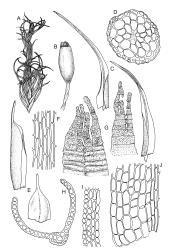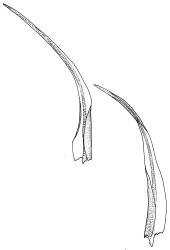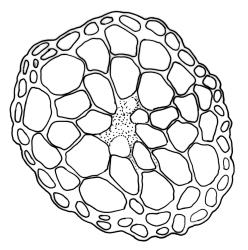Plants yellow- or brown-green, dull, corticolous. Stems mostly c. 5–7 mm, in cross-section with a rather large central strand and one layer of thick-walled cortical cells; with sparse, smooth, pale brown rhizoids below. Leaves erect to loosely secund when moist, slightly contorted when dry, narrowly lanceolate, entire throughout or sometimes crenulate at extreme apex, c. 2.1–3.1 mm; mid laminal cells mostly oblong or subquadrate, sometimes short-rectangular, c. 6 µm wide, incrassate, unistratose (at mid leaf) but becoming bistratose towards apex, smooth, becoming gradually more elongate and more irregular towards base; basal cells oblong to long-rectangular, mostly c. 27–45(–60) × 8–12 µm (some longer near costa), non-porose, some projecting weakly at upper ends; alar cells differentiated in a medium-sized group of c. 6–8 moderately inflated cells, extending about halfway to costa and 3–5 cells up the margin, grading gradually into basal laminal cells. Costa occupying c. ⅙ the width of the leaf base, filling the upper c. ⅙ or more of the leaf (which is predominantly bistratose), in cross-section lacking stereids.
Mostly paroicous. Inner perichaetial leaves c. 1.0–1.5 mm, abruptly tapered from an oblong and tubulose base to a short and stout cusp c. ⅕ or less the total leaf length, ecostate; the outer perichaetial leaves abruptly tapered to a slender acumen. Antheridia axillary at base of outer perichaetial leaves or in perigonial buds at base of the perichaetia. Setae 6–10 mm, ± straight, slender, pale yellow-brown; capsules erect, cylindric, 1–1.5 mm, not strumose, smooth (but empty capsules weakly sulcate when dry); exothecial cells thin-walled and irregular in outline; annulus differentiated, not revoluble; operculum c. two-thirds the capsule length. Peristome teeth inserted at mouth, c. 180–240 µm long (variable in single capsule), mostly divided c. ⅔ their length (occasionally divided only to ⅓ or rarely ± irregular in outline and cribose), with a clear zig-zag line on inner surface, red-orange at base, pale above, distinctly but irregularly striate below, baculate-striate above. Spores spherical, 18–24 µm, finely papillose.
Sainsbury 1955, pl. 20, fig. 3.
NI: Wellington (Waihōhonu, old Ōhakune Hut, Silica Springs Track, Whakapapanui Stream), Taranaki (Fanthams Peak Track); SI: Canterbury (Mt Cassidy).
Endemic.
An earlier collection (G.O.K. Sainsbury 5434, CHR 535054, apparently not present at WELT) from the Waihōhonu type locality was collected from southern beech (unspecified species) bark; peristome details are more easily observed in this collection than in the type. Fanthams Peak material is from "bark of subalpine scrub". Material from west-facing slopes (Con’s Track) on Mt Cassidy grew on a bole c. 25 cm above the base of a Fuscospora solandri s.l. growing within 15 vertical metres of the tree limit. It there forms corticolous cushions from 25 to 50 mm diam.
On the North I. ranging at least from c. 1100 m (Waihōhonu) to c. 1370 m (near the old Ōhakune Hut). A collection from Fanthams Peak on Mt Taranaki is from c. 1220 m. At Mt Cassidy it has been found only very close to the tree line at 1200 m.
Collections made in 2011 from Mt Cassidy include Dicranoloma robustum ("setosum" growth form), Leptostomum inclinans, and Rhaphidorrhynchium amoenum, as well as the hepatics Frullania colliculosa, Plagiochila deltoidea, and Radula splendida growing in close association. At the base of the beech trunk Dicranoloma robustum, Leptostomum inclinans, and Chandonanthus squarrosus occurred abundantly. Other herbarium collections include D. robustum ("setosum" growth form), R. amoenum, Ulota lutea, U. viridis, Jamesoniella monodon, and various species of Frullania and Lejeuneaceae in mixture.
During a focused search on Mt Cassidy in 2011 two collections (from a single trunk of dwarfed Fuscospora solandri tree growing within 15 vertical metres of the tree limit (A.J. Fife 13206 & 13207, CHR) were made before searching was stopped because of fading light. The species appears to be rare at this site, but the habitat does not seem in any way distinctive compared to other tree-line sites in the Arthur’s Pass area. Approximately 4 hours were spent in favourable conditions searching both corticolous and terrestrial habitats (via Con’s track) from c. 1050 m to 1220 m (the latter elevation being slightly above the tree line). Two of the 4 hours were spent in immediate proximity to the tree line. With the exception of these recent collections, all known collections of this species were made prior to 1947. The rarity of collections probably reflects the inconspicuous nature of the species and its lack of readily observable field characters; the species may be more common in exposed subalpine habitats than the collections suggest. Kiaeria spenceri (cited as Dicranoweisia spenceri) is given a N.Z. conservation status of "Nationally Endangered" by Rolfe et al. (2016).
Dixon & Sainsbury’s protologue (Sainsbury 1945) clearly indicated Sainsbury 975 in herb. Sainsbury as the type, and consequently WELT M029498 and M005693 should collectively be considered as the Holotype. This conforms with the concept of holotype outlined in the ICN (Melbourne Code), especially the example of a holotype consisting of more than one fragment of a single collection given in Art. 8.3. (McNeill et al. 2012). Ochyra (in herb.) cited the duplicate of Sainsbury 975 in the Dixon herbarium as a lectotype, and referred it to Kiaeria pumila (Mitt.) Ochyra. Neither his choice of lectotype nor his synonymy are accepted here.
The present species is clearly misplaced in the genus Dicranoweisia. Kiaeria spenceri has dicranaceous and persistent peristome teeth, which are striate-baculate throughout, with a distinct zig-zag line on the inner surface, and unevenly divided for c. ⅔ their length; these peristome features clearly distinguish it from the genus Dicranoweisia (and D. antarctica in particular), in which the teeth are fugacious, lack a zig-zag line, are undivided, and very coarsely baculate (but not striate) throughout on both surfaces. The presence of a well-differentiated but non-revoluble annulus, the presence of conspicuous stomata in the capsule neck, the absence of costal stereids, and the thin-walled nature of the stem medullary cells further distinguish K. spenceri from species of Dicranoweisia.
Sainsbury (1955, p. 120) is, however, correct to state that sterile material of K. spenceri is difficult to distinguish from D. antarctica. On Mt Cassidy the two species were found growing within c. 25 m of each other, the former on bark, the latter on greywacke. The gametophytes were a similar yellow-green when fresh, but the leaves of K. spenceri were c. 2.5 mm, weakly secund, and not contorted when fresh. In the upper laminal cells of K. spenceri (A.J. Fife 13206, CHR 624868) there is a slight suggestion of the cuticular ridges that characterise the genus Dicranoweisia. However, in Mt Cassidy D. antarctica (A.J. Fife 13203, CHR 624865) the cuticular ridges are much more strongly developed and occur through most of the lamina, the leaves are longer (c. 4 mm) and obviously contorted when fresh. The capsules of K. spenceri at Mt Cassidy were narrower, cylindric, 1.5 × 0.45 mm while those of the D. antarctica were broader, obovoid, c. 1.6 × 0.75 mm, and peristome differences distinguish them.
Kiaeria spenceri appears to have little resemblance to the eastern Australian Dicranoweisia microcarpa (Hook.f. & Wilson) Paris.














